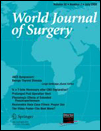Endoscopic Evaluation of Reflux Esophagitis After Proximal Gastrectomy: Comparison Between Esophagogastric Anastomosis and Jejunal Interposition
Abstract
Background
Although proximal gastrectomy has been performed more as a function-preserving surgery, reflux esophagitis can occur postoperatively, resulting in poor postoperative quality of life. To date, only a few reports have compared the methods of reconstruction performed after proximal gastrectomy, and the method most likely to prevent postoperative reflux esophagitis remains undetermined.
Methods
A retrospective review of 76 patients who underwent proximal gastrectomy with jejunal interposition (JI) or esophagogastrostomy (EG) at the Cancer Institute Hospital between April 1996 and August 2005 was performed. Preoperative characteristics, operative findings, and postoperative gastrointestinal fiberoscopy findings were reviewed and compared between JI and EG patients. Furthermore, we investigated the relationship between the length of interposed segment and operative and postoperative findings.
Results
The frequency of grade C or D reflux esophagitis was lower in the JI group than in the EG group (p = 0.001), although the former required a longer operation time (256.5 ± 10.2 min) than the latter (195.8 ± 8.2 min; p < 0.001). Other characteristics and postoperative clinical course did not differ between the groups. In the JI group, interposed segments 10 cm or shorter were advantageous in evaluating the remnant stomach when compared with interposed segments longer than 10 cm. No relationship was observed between the length of the interposed segment and clinical findings, except operation time.
Conclusion
Jejunal interposition helps prevent reflux esophagitis after proximal gastrectomy. The optimal length of the interposed segment is undetermined; however, a length of 10 cm or shorter is preferred for endoscopic evaluation of the remnant stomach.




